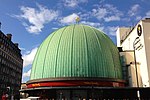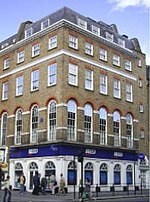Baker Street tube station
Bakerloo line stationsCharles Walter Clark railway stationsCircle line (London Underground) stationsFormer Baker Street and Waterloo Railway stationsFormer Metropolitan Railway stations ... and 11 more
Grade II* listed buildings in the City of WestminsterGrade II* listed railway stationsHammersmith & City line stationsJubilee line stationsLondon Underground Night Tube stationsMetropolitan line stationsRail transport stations in London fare zone 1Railway stations in Great Britain opened in 1863Railway stations in Great Britain opened in 1906Tube stations in the City of WestminsterUse British English from August 2012

Baker Street is a London Underground station at the junction of Baker Street and the Marylebone Road in the City of Westminster. It is one of the original stations of the Metropolitan Railway (MR), the world's first underground railway, opened on 10 January 1863.The station is in Travelcard Zone 1 and is served by five lines. On the Circle and Hammersmith & City lines it is between Great Portland Street and Edgware Road. On the Metropolitan line it is between Great Portland Street and Finchley Road. On the Bakerloo line it is between Regent's Park and Marylebone, and on the Jubilee line it is between St John's Wood and Bond Street.
Excerpt from the Wikipedia article Baker Street tube station (License: CC BY-SA 3.0, Authors, Images).Baker Street tube station
Marylebone Road, London Marylebone
Geographical coordinates (GPS) Address Website Nearby Places Show on map
Geographical coordinates (GPS)
| Latitude | Longitude |
|---|---|
| N 51.522 ° | E -0.157 ° |
Address
The Globe
Marylebone Road 43-47
NW1 5JY London, Marylebone
England, United Kingdom
Open on Google Maps










